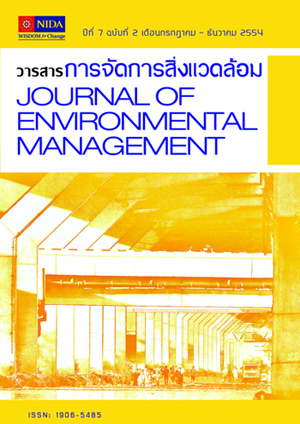การจัดการเทคโนโลยีน้ำยาเคลือบเถ้าใบยางพลวงในท้องถิ่นมาใช้ในผลิตภัณฑ์ศิลาดล Management of Dipterocarpus tuberculatus Roxb Ash Glaze Technology for Celadon Products
บทคัดย่อ
การ ศึกษาครั้งนี้มีวัตถุประสงค์เพื่อหาองค์ประกอบทางเคมีของเถ้าใบยางพลวงที่ สำคัญต่อการเกิดเคลือบผิวเครื่องปั้นดินเผาในเถ้าใบยางพลวง และนำเถ้าใบยางพลวงมาใช้เป็นส่วนผสมของน้ำยาเคลือบขี้เถ้าเพื่อพัฒนาศิลาดล ผลการศึกษา พบว่า ปริมาณองค์ประกอบทางเคมีหลักที่มีความสำคัญต่องานเครื่องปั้นดินเผา ได้แก่ สารประกอบออกไซด์ของซิลิกอนแคลเซียม โพแตสเซียม แมกนีเซียม ฟอสฟอรัส แมงกานีส ซัลเฟอร์ เหล็ก อะลูมิเนียม คลอรีน และแบเรียม ส่วนปริมาณองค์ประกอบทางเคมีรอง ได้แก่ สารประกอบออกไซด์ของสตรอนเทียม ติตาเนียม นิเกิล ทองแดง และรูบิเดียม จากผลการทดลองตัวอย่างที่ 32 (จากตัวอย่างทั้งหมด 36 ตัวอย่าง) เป็นตัวอย่างที่ดีที่สุด ซึ่งมีอัตราส่วนผสมของน้ำยาเคลือบขี้เถ้าเพื่อพัฒนาศิลาดลดังนี้ เถ้าใบยางพลวงร้อยละ 30 โดยน้ำหนัก ดินชุดที่ 56 บี ร้อยละ 40 โดยน้ำหนัก และโพแตสเฟลด์สปาร์ ร้อยละ 30 โดยน้ำหนักเผาที่อุณหภูมิ 1,250 องศาเซลเซียส บรรยากาศการเผาแบบรีดักชั่น จะได้เคลือบสีเขียวศิลาดล เขียวอมขาว หรือเขียวหม่น ซึ่งมีลักษณะคล้ายศิลาดล
The purposes of this research were to determine chemical composition of Dipterocarpus tuberculatus Roxb in relation to ash glaze production of celadon products and to experiment using Dipterocarpus tuberculatus Roxb as one element in the mixture of ash glaze in producing celadon. The findings revealed that major chemical components for ceramic works were SiO2, CaO, K2O, MgO, P2O5, MnO, SO3, Fe2O3, Al2O3, Cl and BaO; whereas the minor elements were SrO, NiO, CuO and RB2O. From the experiment, sample number 32, from the total of 36 samples, was judged to be the best. The composition of ash glaze in developing celadon for this sample was comprised 30% of Dipterocarpus tuberculatus Roxb ash, 40% of 56B clay and 30% of Potash Feldspar by weight. The sample was burned in reduction firing, descending from 1,250 degrees Celsius. The obtained haracteristic of this sample was similar to that of celadon.



